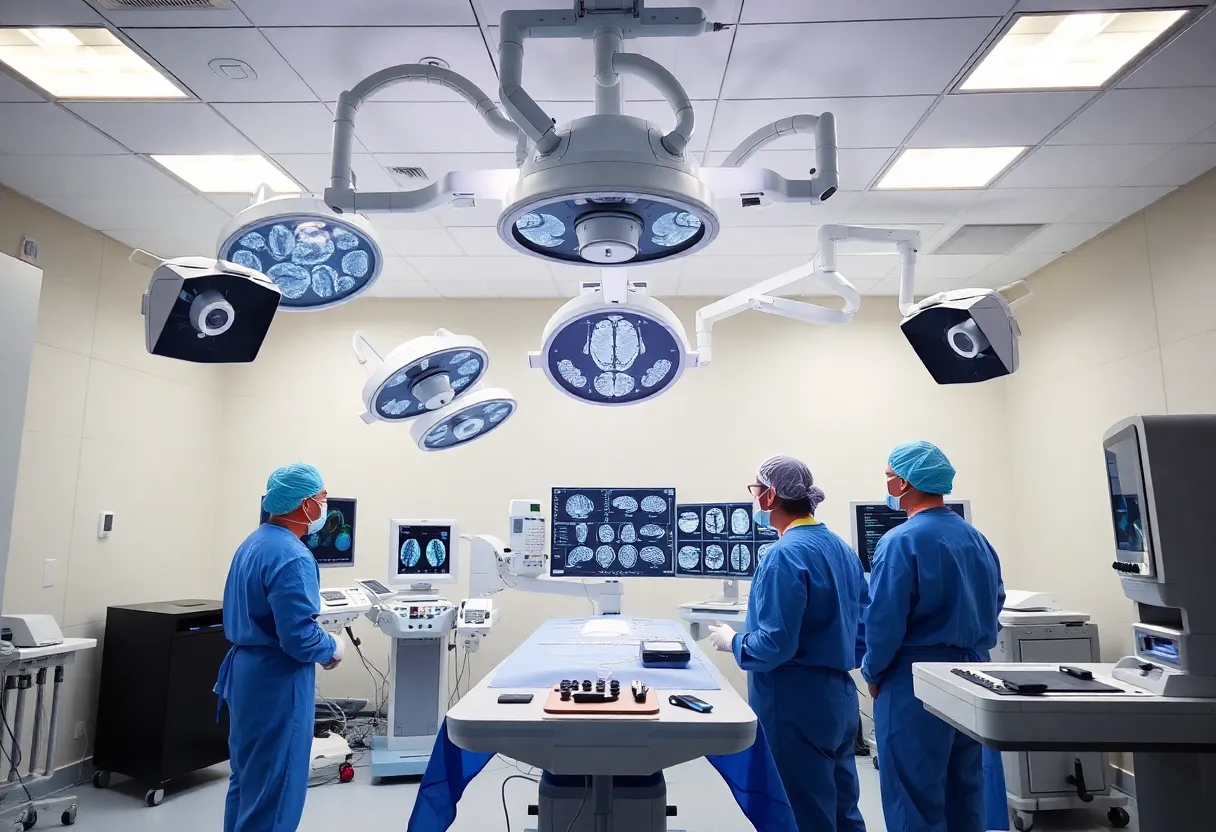Washington, D.C., August 7, 2025
News Summary
George Washington University Hospital’s Neurosciences Institute has implemented advanced neurointerventional biplane technology to improve patient care. This sophisticated imaging system enhances visualization of blood vessels in the brain and spine, allowing for safer, more effective surgical procedures. The technology minimizes radiation exposure and expands treatment options for various neurological conditions. In addition to innovative imaging, GW Hospital employs collaborative practices across medical disciplines to ensure quality patient care, fostering an environment for medical training and advanced therapies.
Washington, D.C. Enhances Patient Care with Advanced Neurosurgery Technology
The Neurosciences Institute at George Washington University Hospital has introduced neurointerventional biplane technology, marking it as one of the most advanced imaging systems available in the region. This cutting-edge technology improves patient care by enhancing imaging quality and providing advanced visualization capabilities for diagnosing and treating various neurological conditions.
The biplane technology allows neurosurgeons to create three-dimensional renderings of blood vessels in the brain and spine, which significantly aids in procedures such as aneurysm repairs, stroke treatments, and evaluations for brain tumors. Notably, this innovative approach exposes both patients and hospital staff to less radiation compared to traditional imaging methods, thereby making it a safer option during medical interventions.
Furthermore, the range of conditions that can be treated using this advanced technology continues to expand. Some of the applications now include interventional spine procedures and carotid revascularization, in addition to addressing traumatic brain injuries and complex neurological diseases.
One of the strengths of GW Hospital lies in its collaborative environment, where different medical disciplines work together seamlessly. This collaboration not only enhances patient care but also fosters an environment conducive to training the next generation of physicians. The Neurosciences Institute is recognized for its commitment to adopting new technologies that promote safe, efficient care.
In addition to the biplane imaging system, GW Hospital is equipped with other advanced technologies, such as intraoperative MRI and focused ultrasound systems for movement disorders, further enhancing treatment outcomes for patients. The institution aims to uphold high standards of evidence-based medical practices as an academic medical center.
Recent advancements also include MRI-guided focused ultrasound, introduced as a treatment option for conditions such as essential tremor and Parkinson’s disease. This less invasive procedure can be conducted on an outpatient basis, provides immediate symptom relief, and significantly improves the quality of life for patients without the need for incisions or sedation.
GW Hospital is also taking strides towards transitional neurosurgery, focusing on continuity of care for adults who have had childhood neurosurgical conditions. This approach emphasizes the importance of building trust with patients and their families, ensuring comprehensive treatment options are available.
Overall, GW Hospital positions itself with specialized expertise and innovative treatment options, continuing to gain the community’s trust through the provision of high-quality care. The institute’s proactive adoption of advanced technologies highlights its commitment to enhancing patient care and improving health outcomes for the communities it serves.
FAQ Section
What is neurointerventional biplane technology?
Neurointerventional biplane technology is an advanced imaging system that enhances visualization of blood vessels in the brain and spine, allowing neurosurgeons to perform intricate procedures with improved image quality.
What are the benefits of using biplane technology?
This technology reduces radiation exposure for both patients and healthcare staff, while also providing three-dimensional images for more accurate diagnostics and treatment planning.
What types of conditions can be treated with this advanced technology?
The technology is effective in treating aneurysms, strokes, carotid revascularization, brain tumors, traumatic brain injuries, and various interventional spine procedures.
How does GW Hospital ensure high-quality patient care?
The hospital promotes collaboration among different medical disciplines, incorporates state-of-the-art technology, and adheres to high standards of evidence-based practices to enhance patient outcomes.
What other advanced technologies are available at GW Hospital?
In addition to biplane imaging, GW Hospital also utilizes intraoperative MRI and MRI-guided focused ultrasound, which is a minimally invasive treatment option for conditions like Parkinson’s disease.
Key Features of GW Hospital’s Neurosurgery Advancements
| Feature | Description |
|---|---|
| Neurointerventional Biplane Technology | Advanced imaging system that enhances visualization for diagnosing and treating neurological conditions. |
| Lower Radiation Exposure | Safer for patients and staff compared to traditional imaging methods. |
| Expanded Treatment Applications | Treats a variety of conditions including aneurysms and stroke interventions. |
| MRI-guided Focused Ultrasound | Minimally invasive procedure for conditions like essential tremor and Parkinson’s, providing immediate relief. |
| Collaboration Across Disciplines | Fosters better patient care and medical training. |
Deeper Dive: News & Info About This Topic
HERE Resources
Additional Resources
- WTOP: New Technology Offers Hope for GW Hospital Neurosurgery Patients
- Wikipedia: Neurosurgery
- Washington Post: GW Hospital Residents Strike Explainer
- Google Search: GW Hospital Neurosurgery
- WTOP: Brain Surgery with No Incisions – MRI Guided Focused Ultrasound at GW Hospital
- Encyclopedia Britannica: Neurosurgery
- U.S. News: Children’s National Medical Center
- Google News: GW Hospital
Author: STAFF HERE WASHINGTON DC
The WASHINGTON DC STAFF WRITER represents the experienced team at HEREWashingtonDC.com, your go-to source for actionable local news and information in Washington, DC, and beyond. Specializing in "news you can use," we cover essential topics like product reviews for personal and business needs, local business directories, politics, real estate trends, neighborhood insights, and regional news affecting the area—with deep expertise drawn from years of dedicated reporting and strong community input, including local press releases and business updates. We deliver top reporting on high-value events such as the National Cherry Blossom Festival, Kennedy Center Honors, and the Washington Auto Show. Our coverage extends to key organizations like the Greater Washington Board of Trade and Destination DC, plus leading businesses in government contracting and technology that power the local economy such as Lockheed Martin and Amazon. As part of the broader HERE network, we provide comprehensive, credible insights into the dynamic landscape of the Washington metropolitan area.





